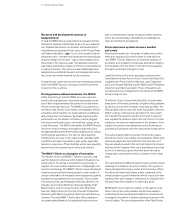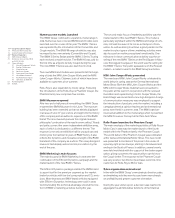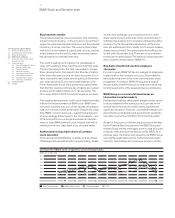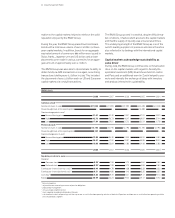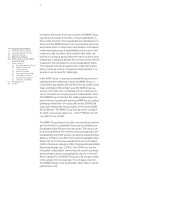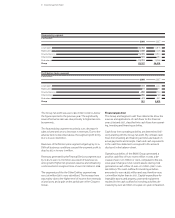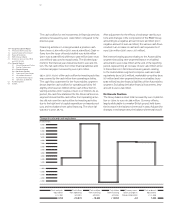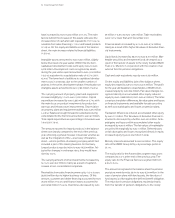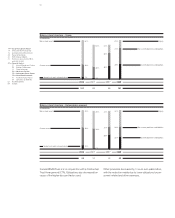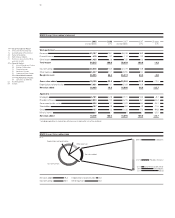BMW 2008 Annual Report Download - page 46
Download and view the complete annual report
Please find page 46 of the 2008 BMW annual report below. You can navigate through the pages in the report by either clicking on the pages listed below, or by using the keyword search tool below to find specific information within the annual report.
47 Group Management Report
Group Internal Management System
In conjunction with the strategy Number ONE, the BMW
Group has also continued to develop its groupwide inter-
nal management system. Processes are now focused even
more sharply on profitability and long-term value growth.
Coherent management of capital employed at all levels
means that the efficient use of capital funds is a prime cri-
terion at project, segment and Group levels. The targets
set
for the Automobiles, Motorcycles and Financial Services
segments all stem from this objective.
Within the Auto-
mobiles and Motorcycles segments, capital employed is
managed at the level of individual product, process and
infrastructure projects. By contrast, the credit and lease
portfolios of the Financial Services segment are managed
primarily on the basis of a cash flow and risk approach.
Minimum rate of return derived from cost of capital
The cornerstone of the value-added management of the
BMW Group is the entity-specific minimum rate of return,
derived from capital market data and based on the weighted
average cost of capital (WACC) as follows:
Cost of equity capital x fair value of equity capital
Fair value of equity and debt capital
WACC = +
Cost of debt capital x fair value of debt capital
Fair value of total capital
The cost of equity capital is measured using the Capital
Asset Pricing Model (CAPM). The cost of debt capital is
based partly on the average interest rate paid for long-term
external debt and partly on the interest rate applicable for
pension obligations.
Value management in the context of project control
Strategic priorities set at a functional level are based on
segment-specific strategies and on the project decisions
reached in accordance with those strategies. The close
link between segment-specific strategies and project
objectives ensures that the project development process
remains effective. Once a positive decision has been
reached for a particular project, it is managed over time
using a value-based approach. Projects are
monitored
continuously and resources reallocated according to re-
quirements.
The project decision and related project selection are
important aspects of value-based management for the
BMW Group. Project decisions are taken on the basis of
net present values (NPVs) and rates of return: this involves
computing the present value of cash flows and the inter-
nal project rate of return (or model rate of return in the case
of vehicle projects) expected to be generated by a project
decision and comparing the results with competitive mar-
ket values.
In this way, the amount by which a project will contribute
to the total value of the segment can be measured when
the project decision is taken. Targets and performance are
controlled using project-related target NPVs and individual
cash-flow-related parameters which have an impact on
those values.
The NPV of a project programme is computed by identi-
fying the cash flows of all related projects and discounting
them back to a specific date. This value serves as an im-
portant target for the Automobiles and Motorcycles seg-
ments. The business value of each segment is measured
after adjusting for the fair value of debt capital. The objec-
tive for the Automobiles and Motorcycles segments is to
increase the value of the business continually.
Return on Capital Employed
Earnings for Capital Return on
ROCE purposes employed Capital Employed
in euro million in euro million in %
2008 2007 2008 2007 2008 2007
BMW Group 639 4,193 28,315 27,321 2.3 15.3
Automobiles 690 3,450 14,056 13,953 4.9 24.7
Motorcycles 60 80 432 444 13.9 18.0
Analysis of the Group Financial Statements
Capital employed by BMW Group
in euro million
2008 2007
Group equity 21,766 20,303
+ Financial liabilities 2,832 2,247
+ Pension provisions 3,717 4,771
Capital employed 28,315 27,321


